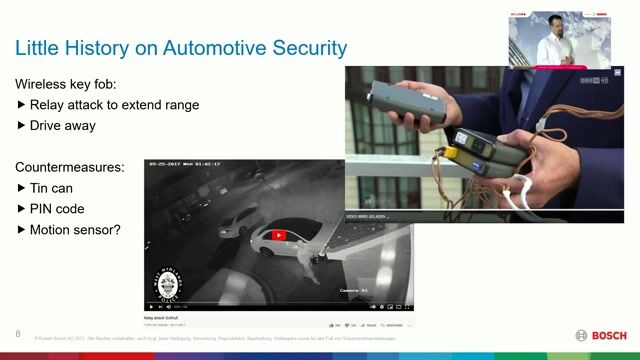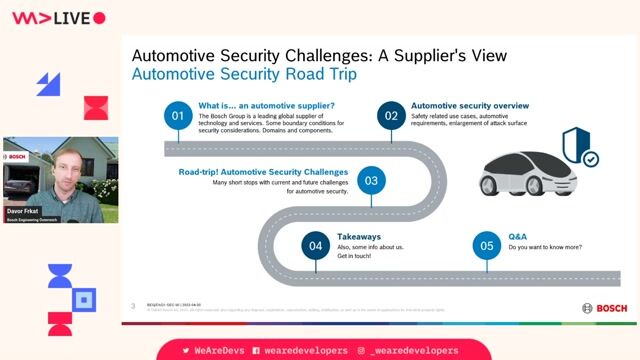Jovan Zivanovic
Reverse Vending Machine (RVM) Security: Real World Exploits / Vulnerabilities
#1about 3 minutes
The financial incentive for hacking reverse vending machines
Reverse vending machines present a security risk because they exchange returned bottles for money, creating an opportunity for financial exploits.
#2about 4 minutes
Understanding the bottle detection and refund process
RVMs use a combination of sensors like barcode scanners, weight sensors, shape detectors, and material analysis to validate and process returned bottles.
#3about 4 minutes
Categorizing common reverse vending machine attack vectors
Attacks on RVMs fall into three main categories: insider manipulation, tricking the bottle acceptance system, and misclassifying bottles for higher payouts.
#4about 4 minutes
Analyzing supermarket receipts to find security flaws
By collecting and comparing receipts from different supermarket chains, researchers identified patterns in barcode generation to find potential vulnerabilities.
#5about 4 minutes
Discovering a predictable and static barcode vulnerability
One supermarket chain used a static EAN-13 barcode on receipts where the refund amount was directly encoded, making it easy to forge.
#6about 2 minutes
Forging a valid receipt with a script and printer
A simple script and a thermal printer can generate a forged receipt with a custom refund amount that is accepted by the store's checkout system.
#7about 2 minutes
The vendor response to the disclosed vulnerability
The RVM manufacturer confirmed the vulnerability and stated that the secure, cloud-validated solution is an optional feature that customers must pay extra for.
#8about 3 minutes
Finding similar and new exploits in Finland's RVMs
An investigation in Finland revealed the same receipt forgery vulnerability, plus a new attack involving swapping barcode stickers on bottles to claim a higher refund.
#9about 2 minutes
Mitigating receipt fraud with a cloud validation system
The most effective way to prevent receipt forgery is to use a centralized data store that generates a unique ID for each receipt and invalidates it after one use.
#10about 9 minutes
Q&A on blockchain, pentesting, and ethical implications
The speaker discusses using blockchain for validation, the importance of early security involvement and pentesting, and the ethics of exploiting recycling systems.
Related jobs
Jobs that call for the skills explored in this talk.
Java Softwareentwickler Kartenautorisierung (m/w/d)
Finanz Informatik
Frankfurt am Main, Germany
Intermediate
Matching moments

22:44 MIN
Examining IDOR vulnerabilities in major companies
How to Cause (or Prevent) a Massive Data Breach- Secure Coding and IDOR

07:52 MIN
A practical demonstration of exploiting IDOR vulnerabilities
How to Cause (or Prevent) a Massive Data Breach- Secure Coding and IDOR

12:10 MIN
Understanding common intruder attack vectors
Securing Your Web Application Pipeline From Intruders

07:45 MIN
Vulnerabilities in keyless entry and vehicle data
Cyber Security: Small, and Large!

08:22 MIN
How attackers exploit developers and packages
Vue3 practical development

09:25 MIN
Securing against AI-driven supply chain attacks
WeAreDevelopers LIVE: What's happening to React?, All-in-one editors, Fireships and Firebases & more

22:43 MIN
The current state of LLM security and the need for awareness
ChatGPT, ignore the above instructions! Prompt injection attacks and how to avoid them.

00:03 MIN
Why developers are a prime target for attackers
You click, you lose: a practical look at VSCode's security
Featured Partners
Related Videos
 57:47
57:47Cracking the Code: Decoding Anti-Bot Systems!
Fabien Vauchelles
 33:29
33:29Programming secure C#/.NET Applications: Dos & Don'ts
Sebastian Leuer
 28:41
28:41101 Typical Security Pitfalls
Alexander Pirker
 37:32
37:32Cyber Security: Small, and Large!
Martin Schmiedecker
 43:56
43:56Getting under the skin: The Social Engineering techniques
Mauro Verderosa
 58:19
58:19Typed Security: Preventing Vulnerabilities By Design
Michael Koppmann
 58:59
58:59Automotive Security Challenges: A Supplier's View
Davor Frkat
 24:01
24:01What The Hack is Web App Sec?
Jackie
From learning to earning
Jobs that call for the skills explored in this talk.

Senior PHP Developer (NL based only)
Online Payment Platform
Delft, Netherlands
€75-95K
Senior
PHP
MySQL
Laravel

(Senior) Security Plattform Engineer / Security Engineer
REWE Group
Remote
€60K
Senior
Perl
Python
Splunk
+4

Systems Engineer IT Network Security
Varta Microbattery GmbH
DNS
Python
Routing
Powershell
Network Security





Embedded Security Engineer - Schwachstellenanalyse | Car IT | Secure Coding
Prognum Automotive GmbH
Remote
C++
